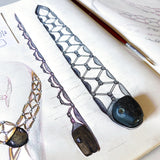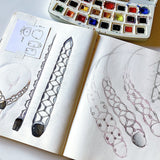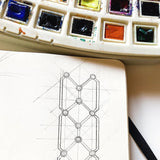SUMMA ALU SNAKE NECKLACE
UNIQUE CREATION
ANCIENT · MIDDLE EAST
We attend all our customers personally. Please leave us your contact details for information and sales.
We attend all our customers personally. Please leave us your contact details for information and sales.
DESCRIPTION
ORIGINAL MESOPOTAMIAN SNAKE SEAL (3000 BC) · We acquired this 5000 years old snake amulet nearly two years ago. It is an exceptional piece in many aspects: its shape, its history and of course its magical symbolism. We have been brainstorming designs for more than a year, and now it is finally leaving the drawing desk and entering the modelling phase. This necklace has taken more than a year to design, it will take more than six months to model and build.
We will settle for nothing less than creating the exceptional piece of high jewelry that would be worn by Eve herself if the garden of Eden had a red carpet.
-
Steatite Mesopotamian snake seal (3000 BC)
-
Articulated design
-
18k yellow gold
-
VVS G grade diamonds

MESOPOTAMIAN SNAKE SEAL (3000 BC)
Seal amulets with stylized animals were characteristic for the Jemdet Nasr period (3100 BC - 2900 BC). These pendants were worn as talismans to protect against evil and to increase the wearer’s power. Different animals had different meanings, some directly linked to a deity. It is a historical misconception to create lines of division between magic, religion and healing. Ancient Near Easterners approached these in a very different way.
This snake amulet is carved of black steatite, with the pattern of the seal articulated by a series of engraved lines. The role of snakes in ancient Mesopotamian mythology and art was dual. Snakes were considered a source of chaos, mischief and death, and at the same time linked to healing, rebirth and renewal.
Seal amulets with stylised animals are characteristic for the Jemdet Nasr period (3100 BC - 2900 BC) and have been found throughout Mesopotamia.



-
E. Douglas Van Buren, Amulets in ancient Mesopotamia
-
B. Buchanan, Early Near Eastern Seals in the Yale Babylonian Collection
-
D.E. Smith, The divining snake: reading Genesis in the context of Mesopotamian ophiomancy
-
Summa Alu tablets 22-26, omens of snakes
-
J. Day, The serpent in the garden of Eden and its background
-
W. R. J. Golding, Perceptions of the serpent in the ancient near east: its bronze age role in apotropaic magic, healing and protection
-
R. A. Veenker, Gilgamesh and the magic plant
Acquired at an antiquities dealer in Washington DC, legally imported to the European Union classified as a collector’s piece of archeological interest. Authenticity has been certified by S.M.G., a member of the Archaeological Institute of America.
Before that the piece was part of the James Stephen collection. Dr. Stephen was a US intelligence officer who also held a degree in archaeology. He was posted in the Anatolian region of Turkey during the late 1960s with the US government and during this time acquired his collection throughout the region. We have a copy of the original records of these acquisitions.
SUMMA ALU MAGIC
Life is magic, as it always has been. As science is shaping us into a new homo deus, artificial intelligence and genetic enhancements are breaking the boundaries of cognition and mortality. Yet, scientists remain ignorant on core issues like human conscience and the origin of the universe. Life is magic, as it always has been. Homo sapiens’ quest for answers forwards us to our future, and connects us to our original past, to ancient myths of magical serpents.

In many civilizations animals have been at the core of religion and mythology. The ancient Mesopotamians had a dual relationship with snakes. Their shedding and renewal of skin made them a token for protection and healing. The snake staff symbol still represents healthcare today. As venomous bringers of death, they were also regarded as factors of chaos and mischief.
Our division of science, magic and religion did not exist in ancient times. Early scholars studied and classified causality of omens. The Mesopotamian Summa Alu tablets contain some 500 snake related omens, structured in a most modern “IF - THEN” fashion. “If in a man's house a snake enters carrying a mouse in its mouth, that house will experience release.” Omens were logic, the magic of the unknown a driving force for the creation of both myths and science.
Some 5000 years ago this snake seal was worn by its bearer as an amulet of logical beliefs. It is now a testament to modern science rooted in ancient questions. It connects us to the eternal quest of the magic of life.






